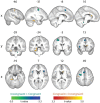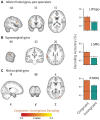This is a preprint.
Neural Basis Of Sound-Symbolic Pseudoword-Shape Correspondences
- PMID: 37425853
- PMCID: PMC10327042
- DOI: 10.1101/2023.04.14.536865
Neural Basis Of Sound-Symbolic Pseudoword-Shape Correspondences
Abstract
Non-arbitrary mapping between the sound of a word and its meaning, termed sound symbolism, is commonly studied through crossmodal correspondences between sounds and visual shapes, e.g., auditory pseudowords, like 'mohloh' and 'kehteh', are matched to rounded and pointed visual shapes, respectively. Here, we used functional magnetic resonance imaging (fMRI) during a crossmodal matching task to investigate the hypotheses that sound symbolism (1) involves language processing; (2) depends on multisensory integration; (3) reflects embodiment of speech in hand movements. These hypotheses lead to corresponding neuroanatomical predictions of crossmodal congruency effects in (1) the language network; (2) areas mediating multisensory processing, including visual and auditory cortex; (3) regions responsible for sensorimotor control of the hand and mouth. Right-handed participants ( n = 22) encountered audiovisual stimuli comprising a simultaneously presented visual shape (rounded or pointed) and an auditory pseudoword ('mohloh' or 'kehteh') and indicated via a right-hand keypress whether the stimuli matched or not. Reaction times were faster for congruent than incongruent stimuli. Univariate analysis showed that activity was greater for the congruent compared to the incongruent condition in the left primary and association auditory cortex, and left anterior fusiform/parahippocampal gyri. Multivoxel pattern analysis revealed higher classification accuracy for the audiovisual stimuli when congruent than when incongruent, in the pars opercularis of the left inferior frontal (Broca's area), the left supramarginal, and the right mid-occipital gyri. These findings, considered in relation to the neuroanatomical predictions, support the first two hypotheses and suggest that sound symbolism involves both language processing and multisensory integration.
Highlights: fMRI investigation of sound-symbolic correspondences between auditory pseudowords and visual shapesFaster reaction times for congruent than incongruent audiovisual stimuliGreater activation in auditory and visual cortices for congruent stimuliHigher classification accuracy for congruent stimuli in language and visual areasSound symbolism involves language processing and multisensory integration.
Figures





Similar articles
-
Neural basis of sound-symbolic pseudoword-shape correspondences.Neuropsychologia. 2023 Sep 9;188:108657. doi: 10.1016/j.neuropsychologia.2023.108657. Epub 2023 Aug 3. Neuropsychologia. 2023. PMID: 37543139 Free PMC article.
-
Neural Basis of the Sound-Symbolic Crossmodal Correspondence Between Auditory Pseudowords and Visual Shapes.Multisens Res. 2021 Aug 11;35(1):29-78. doi: 10.1163/22134808-bja10060. Multisens Res. 2021. PMID: 34384048 Free PMC article.
-
Stimulus Parameters Underlying Sound-Symbolic Mapping of Auditory Pseudowords to Visual Shapes.Cogn Sci. 2020 Sep;44(9):e12883. doi: 10.1111/cogs.12883. Cogn Sci. 2020. PMID: 32909637 Free PMC article.
-
Effects of congruent and incongruent visual cues on speech perception and brain activity in cochlear implant users.Brain Struct Funct. 2015 Mar;220(2):1109-25. doi: 10.1007/s00429-013-0704-6. Epub 2014 Jan 9. Brain Struct Funct. 2015. PMID: 24402676
-
Eye movements reveal persistent sensitivity to sound symbolism during word learning.J Exp Psychol Learn Mem Cogn. 2018 May;44(5):680-698. doi: 10.1037/xlm0000476. Epub 2017 Nov 2. J Exp Psychol Learn Mem Cogn. 2018. PMID: 29094990
References
-
- Ademollo F. (2011). The Cratylus of Plato: A commentary. Cambridge, UK: Cambridge University Press.
-
- Audacity Team (2012) Audacity v2.0.1 [Computer program]. Retrieved from http://audacity.sourceforge.net/ Audacity ® software is copyright © 1999–2014 Audacity Team.
Publication types
Grants and funding
LinkOut - more resources
Full Text Sources
Miscellaneous
